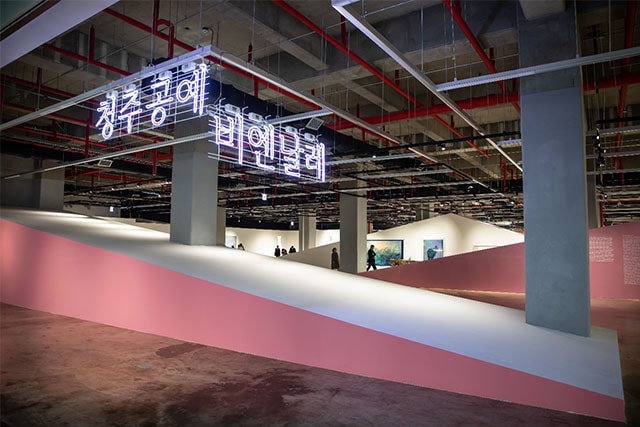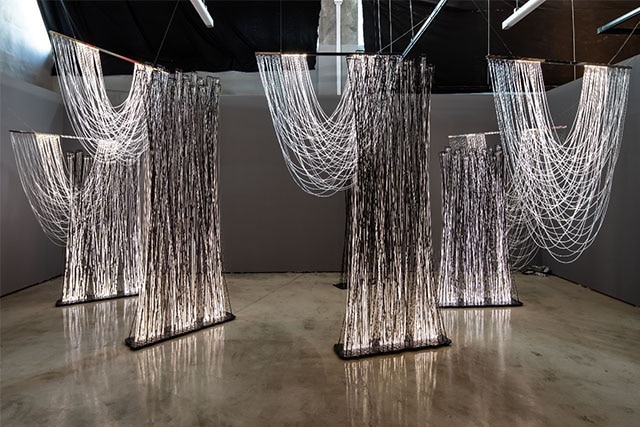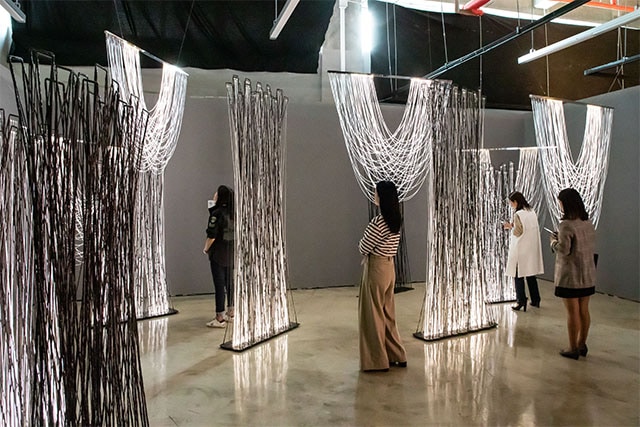LED Meets Art: Artworks Using Samsung’s LEDs at 2019 Cheongju Craft Biennale
Semiconductors-based LEDs convert electrical energy into light energy, and they are used to light up our lives almost everywhere these days. We see LEDs used in products like mobile phones, TVs, cars, lights, and signage in everyday life; now wavelength-specific LEDs are being developed in specialized sectors such as healthcare and agriculture.
Samsung Electronics’ LEDs have been used for a multitude of applications. It is also used to light up something special. The world-renowned architect and designer, Il Hoon Roh created artworks using Samsung’s LEDs and displayed at 2019 Cheongju Craft Biennale (Oct. 8 - Nov. 17).

▲ At the main exhibition hall at the 2019 Cheongju Craft Biennale held in Cheongju City, Chungcheongbuk-do, South Korea
This special collaboration between Samsung Electronics and Il Hoon Roh is second since the first collaboration at Light + Building 2016 in Frankfurt, Germany.
Il Hoon pairs new materials, such as optical fibers and carbon fibers, with a traditional Korean paper string craft called "Jiseung" to celebrate the beauty of nature. Back in June 2017, one of his early works, Rami Bench (2013), was acquired by a world-famous museum of modern art, the Centre Pompidou, for part of its permanent collection. This made him the youngest South Korean artist to add his work to the collections of the Centre Pompidou.
Q. It's been a while since we last saw your work at Light + Building 2016 in Frankfurt. Can you tell us a little bit about your recent projects?
Since my first collaboration with Samsung LEDs at Light + Building 2016 in Frankfurt, I've managed to create artworks that emit the amount of light that I want through optical fibers. I've also continued experimenting on ways to express the beauty of nature by using lines that emit light. I'll be introducing my latest work Rami XII, 2019, the product of my experiments, at the 2019 Cheongju Craft Biennale.

Q. Please tell us about the theme of this exhibition and your works.
The theme of the 2019 Cheongju Craft Biennale is "Dreaming of Crafts of the Future: Mongyudowon Unfolds," which comes from Mongyudowondo (Note: famous painting by Ahn Gyeon of the Joseon Dynasty in 1447, about the Prince Anpyeong Yi Yong’s dream of a journey to the peach blossom land).
Following up on my past works that evoke the beauty of nature, I tried to express the beautiful landscape of Mongyudowon through tree branches made out of lines emitting light.
Just like Mongyudowondo, depicting a dream about paradise where fantasy and reality are intertwined, I wanted to show the external beauty of tree branches through their shapes. I also wanted to bring out the beauty of nature that's hidden in those branches in two artworks, Parabola Chandelier, 2017 and Rami XII, 2019.

▲ Il Hoon Roh's Parabola Chandelier, 2017 and Rami XII, 2019, emitting light from Samsung LEDs
Q. I'd like to know how Samsung’s LEDs were incorporated into your works and what processes you may have used.
I've done quite a lot of research and experimentation to create a line that emits light. Then, one day, I came across optical fibers. I first constructed a plane using multiple light-emitting lines made out of optical fibers. I then installed Samsung’s LEDs on the bar that supports the entire artwork so that the whole plane could emit light.
Throughout this work, I had to deal with the issue of heat generated by the light source. To create the final artwork, I carefully calculated the air flow through simulations and went through a redesigning process such as reducing the size of the light source so that it was small enough to be incorporated.

Q. What led you to choose LEDs rather than other materials?
Optical fiber is material that can carry light from one end to the other, but if you bend it more than a certain degree, the light will leak out. If you twist an optical fiber string by hand, you can angle the light and also produce light rays of different intensities along the string. One drawback of optical fiber is the significant light loss when it travels through the optic fiber. Because of this, I chose Samsung’s LEDs to have my artwork to emit more powerful lights.
Q. What are some advantages of Samsung’s LEDs that you've experienced while working with them?
For artwork that uses LEDs, one of the most important things is that it must emit light consistently. The power cannot be turned on and off during the exhibition period, and in case it ends up in someone's collection, I need to make sure that it doesn't require any maintenance or repair. Considering all of that, I thought Samsung’s LEDs are dependable. That's why I have been using them for my work ever since 2016.

Q. Are you planning to create more artworks using Samsung’s LEDs in the future?
I've been able to produce higher-quality light ever since I started using Samsung’s LEDs. Right now, I'm working on several experiments to produce light that goes even beyond high-quality light. In my past works, I added LEDs to light-emitting optical fibers to make them brighter, but I've been trying to find a way to create something solely out of light-emitting LEDs. I hope that many people come and witness the greatness and beauty of nature through my artworks that emit light through LEDs.


 Copyright ⓒ 1995-2023 SAMSUNG All Rights reserved.
Copyright ⓒ 1995-2023 SAMSUNG All Rights reserved.